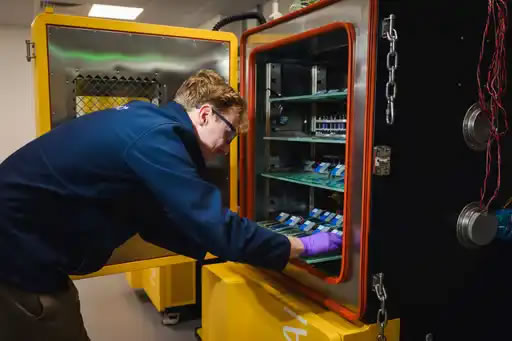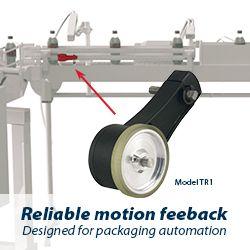Improving AGV efficiencies with updated battery technologies

Advancements in robotics, artificial intelligence, and automation technologies have enabled autonomous guided vehicles (AGVs) to become commonplace in US warehouses, driving operational efficiency, reducing human error, managing labour shortages, and, importantly, operating with zero emissions. AGVs have a crucial role in the country’s $1.34tn eCommerce and $662.48bn pharmaceuticals industries, facilitating much of the manufacturing, sorting, packing, and distribution of products. However, most AGVs in operation today rely on outdated battery technologies that require prohibitively long charging times and provide limited vehicle uptime. New, emerging, innovative battery chemistries can offer the potential to improve AGV efficiency by increasing vehicle uptime, helping to drive efficiencies in business growth and economic prosperity.
What battery technologies are currently powering AGVs?
The most widely used batteries in AGVs are lead-acid GEL or Absorbent Glass Mat (AGM) batteries, a legacy and trusted technology going back to the 1970s. These batteries offer high safety; a crucial element for any business to consider, but are large, heavy, and require an average of 8 hours to charge. Additionally, the average life of GEL/AGM batteries in AGV applications is 2–4 years before replacement is needed. This forces businesses to conduct regular battery swaps or endure lengthy charge times to keep vehicles operational during the required shift rotations of the warehouse, resulting in significant additional costs due to the need for additional AGV or battery units on hand.
Lithium-ion (Li-ion) batteries, more commonly used in modern passenger electric vehicles, provide significantly faster charging than lead-acid batteries, offering a longer cycle life, which requires them to be replaced less frequently. However, the upfront investment associated with Li-ion batteries is higher than that of their lead-acid counterparts, and the still require vehicle downtime to charge, although reduced by ~75%, which creates productivity bottlenecks in 24/7 operations.
What makes for the best AGV battery?
In reality, there is no single ‘best’ battery available on the market today that meets the needs of every AGV, as the right technology comes down to the AGV’s specific requirements and its intended use within an operation. Safety should always be the priority for decision makers, closely followed by cost and performance-driven factors that create a complete total cost of ownership (TCO) for the fleet of AGVs. Key metrics such as cycle life, energy density, charge time, cold or hot temperature performance, in addition to safety, must be considered as a package to determine what the ‘best’ battery solution is for an operation.
It’s important to note that the reference when comparing lead-acid to Li-ion has shifted from comparing a single AGV to evaluating the operation or fleet as a whole. The reason for this? These chemistries create a dramatic shift in AGV performance (run-time, years of life, charge time) and operational characteristics (% of AGVs out of cycle due to charging or battery swap) that make the economics change. On average, Li-ion batteries cost more upfront, but much of that cost is offset because a facility can reduce its AGV or battery swap count by ~30% and extend battery life by 200–300%.
A similar benefit is observed when comparing various Li-ion solutions. While the adoption of common Li-ion chemistries, such as Lithium Iron Phosphate (LFP), Nickel Manganese Cobalt (NMC), and Lithium Titanate Oxide (LTO), has grown significantly over the past 20 years, advanced new solutions are also beginning to emerge on the market. By utilising advanced materials, manufacturing processes, and chemistries, the new generation of batteries can achieve the next leap in charging, lifecycle, safety, as well as industry-leading TCO.
What chemistries can improve AGV efficiency?
As we’ve explored, optimising AGV fleets hinges on batteries that deliver fast charging, long cycle life, and high safety without breaking the bank. Anode materials hold the key to these improvements as they are the battery component that stores lithium ions during charging. This material directly shapes charge speed, energy density, safety, and cycle life, making it the linchpin for boosting AGV productivity in relentless 24/7 operations.
Most Li-ion batteries rely on graphite anodes, which prioritise energy density at the compromise of other areas and take between 1–2 hours to reach 80% charge. For industries like eCommerce and pharmaceuticals, where every minute counts, this translates to oversized (>kWh) or additional batteries (if utilising swapping) for each vehicle, driving up costs and complexity. Graphite also struggles in extreme hot or cold temperatures, raising concerns about operability in areas that incorporate cold storage.
Chemistries like LTO can overcome certain barriers by offering a ~10–20-minute fast charge, high safety, and ultra-long life. However, their trade-off is a very high cost and lower energy density (especially volumetrically), which necessitates the use of bulkier battery packs or more frequent charging events. These are sacrifices that most AGV operators aren’t willing to make, sidelining the technology to more niche applications and preventing widespread adoption.
So, what is the solution? A novel anode material, mixed niobium oxide (XNO®), could hold the key to unlocking greater efficiency and improved batteries for AGVs. At Echion Technologies, our XNO®-powered Li-ion batteries charge safely in under 10 minutes, improve cycle life by 10x (compared to lead-acid) or 2–3x (compared to Li-ion: LFP/NMC), and increase energy density by 50% over LTO. This means smaller, lighter batteries that are focused on keeping AGVs in productive operation and reducing fleet-level costs.
XNO® eliminates the compromises that hinder other technologies. Unlike lead-acid batteries, which demand lengthy 8-hour charging and frequent replacements every 2–4 years, XNO® delivers sub-10-minute charging and a 10x longer cycle, slashing downtime and maintenance costs. Even compared to Li-ion chemistries like LFP and NMC, XNO® offers 2–3 times the cycle life and faster charging, while also increasing overall safety. Even against LTO, XNO®’s 50% higher energy density enables compact batteries that suit diverse AGV fleets, from compact sorters to heavy transporters, without the high cost or bulky designs that limit LTO’s adoption.
This performance translates to fleet-wide savings. By minimising downtime and reducing the need for oversized or extra batteries, XNO® lowers the TCO and enables AGVs to run for more hours per day. Operators can streamline operations, whether in high-throughput eCommerce warehouses or precision-driven pharmaceutical facilities, boosting productivity and profitability.
Beyond performance, XNO® is a sustainable choice. Niobium, the core of XNO®, is abundant, cost-effective, and responsibly sourced. Independent studies show XNO®-based cells have a carbon footprint 2.5 times lower than LTO and significantly greener than traditional lead-acid and graphite-based Li-ion options. Non-toxic and recoverable, XNO® aligns with net-zero goals, offering an environmentally friendly solution without compromising power or efficiency.
How can the industry lead the charge in electrification?
AGV-powered sectors like eCommerce and pharmaceuticals have set the pace for electric adoption, cutting emissions while streamlining operations. Yet, legacy batteries, whether lead-acid’s sluggish charging or Li-ion’s trade-offs in speed, cost, or size, limit progress. XNO®-powered batteries break these barriers, delivering fast charging, unmatched cycle life, high energy density, and sustainability in one package. In 24/7 operations, where every minute impacts the bottom line, adopting next-generation chemistries like XNO® drives efficiency and supports a greener future.
To explore how Echion’s XNO® can transform your AGV fleet, visit: https://www.echiontech.com/.
Featured Product

